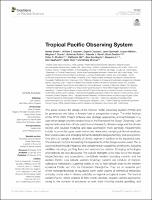Mostrar el registro sencillo del ítem
Tropical Pacific observing system
| dc.contributor.author | Smith, N. | |
| dc.contributor.author | Kessler, W.S. | |
| dc.contributor.author | Cravatte, S. | |
| dc.contributor.author | Sprintall, J. | |
| dc.contributor.author | Wijffels, S. | |
| dc.contributor.author | Cronin, M.F. | |
| dc.contributor.author | Sutton, A. | |
| dc.contributor.author | Serra, Y.L. | |
| dc.contributor.author | Dewitte, Boris | |
| dc.contributor.author | Strutton, P.G. | |
| dc.contributor.author | Hill, K. | |
| dc.contributor.author | Gupta, A.S. | |
| dc.contributor.author | Lin, Xiaopei | |
| dc.contributor.author | Takahashi, Ken | |
| dc.contributor.author | Chen, D. | |
| dc.contributor.author | Brunner, Shelby | |
| dc.date.accessioned | 2020-01-30T23:41:46Z | |
| dc.date.available | 2020-01-30T23:41:46Z | |
| dc.date.issued | 2019-02-18 | |
| dc.identifier.citation | Smith N, Kessler WS, Cravatte S y otros (2019) Tropical Pacific Observing System. Front. Mar. Sci. 6:31. doi: 10.3389/fmars.2019.00031 | es_PE |
| dc.identifier.uri | https://hdl.handle.net/20.500.12542/229 | |
| dc.description.abstract | This paper reviews the design of the Tropical Pacific Observing System (TPOS) and its governance and takes a forward look at prospective change. The initial findings of the TPOS 2020 Project embrace new strategic approaches and technologies in a user-driven design and the variable focus of the Framework for Ocean Observing. User requirements arise from climate prediction and research, climate change and the climate record, and coupled modeling and data assimilation more generally. Requirements include focus on the upper ocean and air-sea interactions, sampling of diurnal variations, finer spatial scales and emerging demands related to biogeochemistry and ecosystems. One aim is to sample a diversity of climatic regimes in addition to the equatorial zone. The status and outlook for meeting the requirements of the design are discussed. This is accomplished through integrated and complementary capabilities of networks, including satellites, moorings, profiling floats and autonomous vehicles. Emerging technologies and methods are also discussed. The outlook highlights a few new foci of the design: biogeochemistry and ecosystems, low-latitude western boundary currents and the eastern Pacific. Low latitude western boundary currents are conduits of tropicalsubtropical interactions, supplying waters of mid to high latitude origin to the western equatorial Pacific and into the Indonesian Throughflow. They are an essential part of the recharge/discharge of equatorial warm water volume at interannual timescales and play crucial roles in climate variability on regional and global scales. The tropical eastern Pacific, where extreme El Niño events develop, requires tailored approaches owing to the complex of processes at work there involving coastal upwelling, and equatorial cold tongue dynamics, the oxygen minimum zone and the seasonal double Intertropical Convergence Zone. A pilot program building on existing networks is envisaged, complemented by a process study of the East Pacific ITCZ/warm pool/cold tongue/stratus coupled system. The sustainability of TPOS depends on effective and strong collaborative partnerships and governance arrangements. Revisiting regional mechanisms and engaging new partners in the context of a planned and systematic design will ensure a multi-purpose, multi-faceted integrated approach that is sustainable and responsive to changing needs. | es_US |
| dc.format | application/pdf | es_PE |
| dc.language.iso | eng | es_PE |
| dc.publisher | Frontiers in Earth Science | es_PE |
| dc.relation.ispartof | urn:issn:2296-7745 | |
| dc.rights | Reconocimiento - No comercial - Sin obra derivada (CC BY-NC-ND) | es_PE |
| dc.rights | info:eu-repo/semantics/openAccess | es_PE |
| dc.rights.uri | https://creativecommons.org/licenses/by-nc-nd/4.0/ | es_PE |
| dc.source | Repositorio Institucional - SENAMHI | es_PE |
| dc.source | Servicio Nacional de Meteorología e Hidrología del Perú | es_PE |
| dc.subject | Investigación oceanográfica | en_US |
| dc.subject | Climatología | en_US |
| dc.subject | Cambio Climático | en_US |
| dc.title | Tropical Pacific observing system | en_US |
| dc.type | info:eu-repo/semantics/article | es_PE |
| dc.identifier.isni | 0000 0001 0746 0446 | |
| dc.description.peerreview | Por pares | es_PE |
| dc.identifier.doi | https://doi.org/10.3389/fmars.2019.00031 | |
| dc.identifier.journal | Frontiers in Marine Science | es_PE |
| dc.subject.ocde | https://purl.org/pe-repo/ocde/ford#1.05.09 | es_PE |
| dc.subject.ocde | https://purl.org/pe-repo/ocde/ford#1.05.10 | es_PE |
| dc.subject.sinia | investigaciones ambientales - Gestión, Fiscalización y Participación Ciudadana Ambiental | es_PE |
| dc.type.sinia | text/publicacion cientifica | es_PE |
| dc.identifier.url | https://hdl.handle.net/20.500.12542/229 | |
| dc.identifier.url | https://hdl.handle.net/20.500.12542/229 |
Ficheros en el ítem
Este ítem aparece en la(s) siguiente(s) colección(es)
-
Artículo científico [176]









